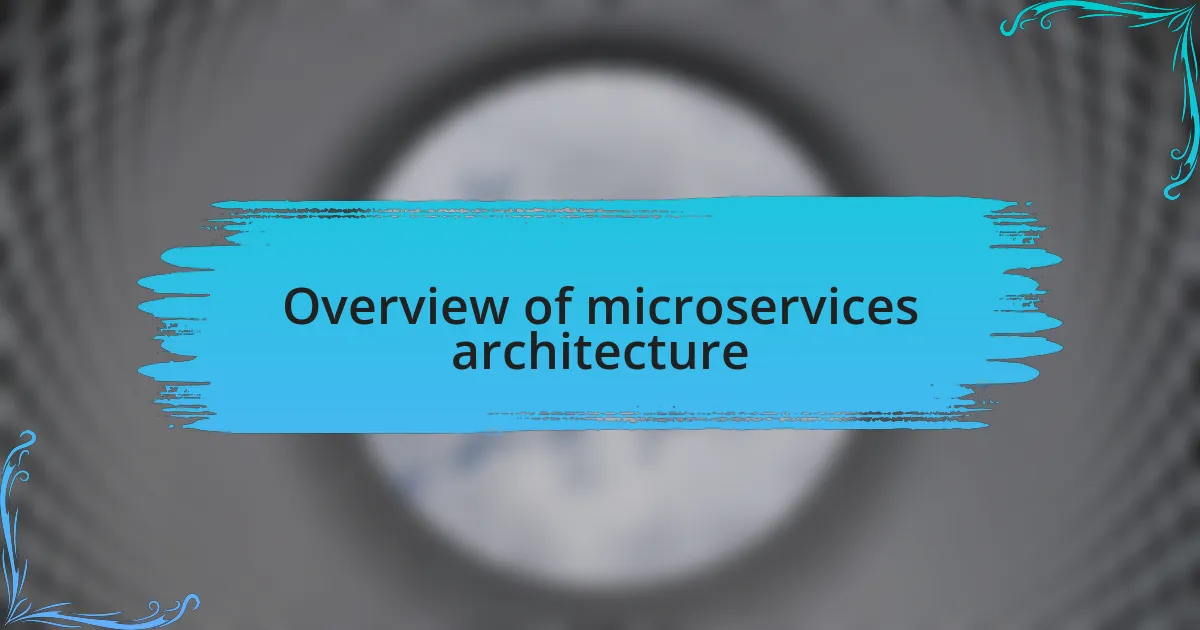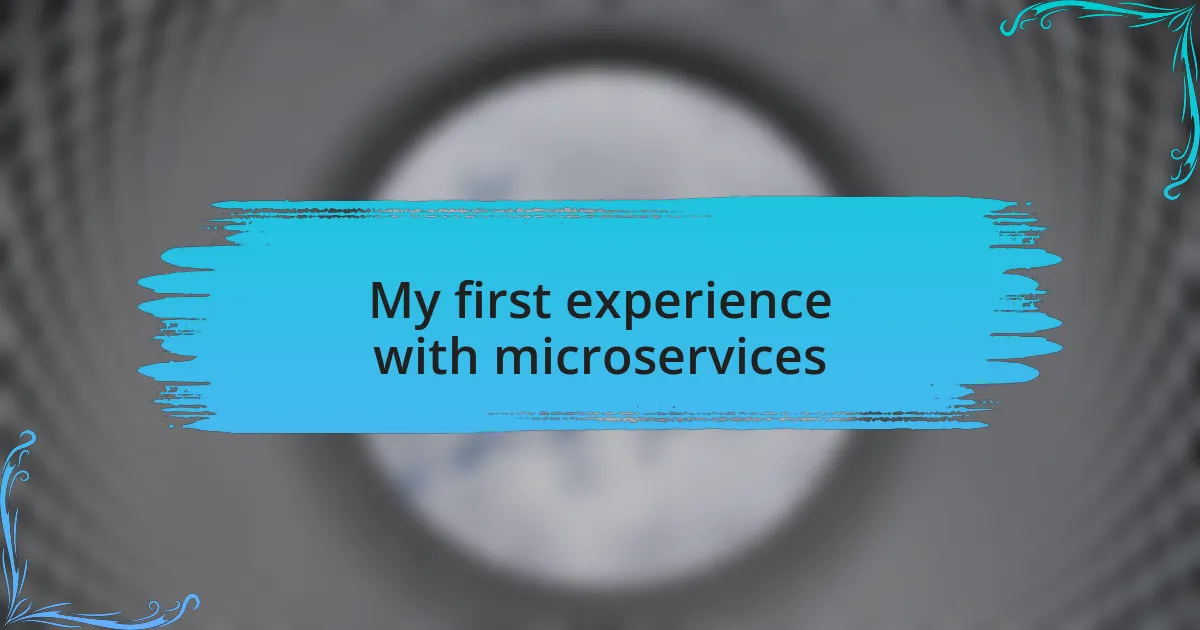Key takeaways:
- Microservices architecture enhances scalability and fault isolation, allowing independent scaling of services while maintaining overall system stability.
- Tools like Docker and Kubernetes significantly simplify the deployment and management of microservices, improving productivity and reliability.
- Transitioning to microservices fosters a culture of innovation and collaboration, transforming deployment cycles from months to days or hours.
- Challenges include managing service dependencies, ensuring data consistency, and optimizing scaling strategies, which ultimately drive growth and adaptability.

Overview of microservices architecture
Microservices architecture is a style where applications are built as a collection of loosely coupled, independently deployable services. Each service handles a specific business function, which allows developers to focus on individual components without being bogged down by the entire system. I remember when I first encountered this approach; it felt like a breath of fresh air compared to the monolithic architecture I was used to.
One of the most compelling advantages of microservices is that they foster innovation and allow for faster iterations. Have you ever felt stuck in a long deployment cycle? With microservices, teams can work on different services simultaneously, which significantly shortens the time from development to deployment. I experienced this firsthand when we shifted to microservices; the increase in our team’s productivity was astonishing, allowing us to deliver features that our users had been eagerly waiting for.
Additionally, microservices lend themselves to scalability, enabling businesses to grow without major rearchitecting. Imagine a growing app that needs to support hundreds, or even thousands, of users—traditional systems can struggle under that pressure. I’ve seen teams successfully manage spikes in demand simply by scaling the specific services that need it, rather than the entire application, which makes a world of difference in performance and resource management.

Key tools for microservices development
When it comes to developing microservices, choosing the right tools is crucial. I’ve found that Docker stands out as a game-changer for containerization. It allows us to package services and their dependencies, ensuring they behave consistently across different development and production environments. Remembering my early days with Docker, I was amazed at how it simplified deployment—it felt like I finally had control over my applications.
Another indispensable tool in our arsenal is Kubernetes. This platform automates the deployment, scaling, and management of containerized applications, making it tremendously easier to handle microservices. I recall a project where we were struggling to manage several services manually; implementing Kubernetes not only streamlined our processes but also improved our system’s reliability dramatically. Isn’t it satisfying to see your services scale effortlessly during peak times?
For monitoring and logging, I highly recommend using tools like Prometheus and Grafana. Keeping an eye on each service’s performance can be daunting, but these tools make it feel like a walk in the park. I remember the first time I set up Grafana dashboards; being able to visualize data in real time transformed our approach to debugging and performance tuning. It’s like having a dashboard for your vehicle; when something’s not right, you know exactly where to look.

Benefits of using microservices
One compelling benefit of using microservices is their ability to enhance scalability. When I started working with a microservices architecture, it was a revelation to see how each service could be scaled independently. It’s like having a garden where you can water the thirsty plants without drenching the entire bed. This flexibility allows us to allocate resources where they’re needed most, especially during high traffic periods.
Another advantage I’ve come across is improved fault isolation. In a project I managed, one service malfunctioned, yet the others continued to operate seamlessly. It felt liberating to know that the entire application wouldn’t crash due to a single point of failure. This resilience is invaluable—it’s reassuring to realize that a fault in one part of the system doesn’t spell disaster for everything else you’ve built.
Microservices also promote quicker deployment cycles. I vividly remember when our team transitioned from a monolithic structure to microservices; we began deploying updates more frequently. Instead of waiting for months for a new version, we could roll out changes in days or even hours. Doesn’t this agility feel like the future of development? Embracing microservices truly transformed our approach to building software, making it not only faster but also more responsive to user needs.

My first experience with microservices
My first experience with microservices was both exciting and daunting. I remember diving into a project where we transformed a clunky monolith into a series of interconnected services. It felt like breaking free from a heavy weight, as if I was finally able to breathe. The initial setup was challenging; figuring out how to structure the communication between services was a puzzle that required patience and creativity.
I vividly recall one instance where our user authentication service decided to throw a tantrum. Instead of panicking, I found myself enjoying the troubleshooting process, knowing that the rest of our application remained unaffected. It was an eye-opening moment for me; I could see the power of microservices in action, allowing me to pinpoint and resolve issues without the fear of taking down the entire system. How liberating is it to address one glitch while the rest of the world continues to roll smoothly?
As I navigated through this new architectural style, I felt a sense of growth in my skills and outlook. Each deployment felt like a learning opportunity, and the collaborative atmosphere among my team members was invigorating. I realized that the microservices journey was not just about technology; it was about evolving mindsets and embracing change. Looking back, I can appreciate how this experience reshaped my approach to problem-solving, fostering a culture of innovation that I still carry with me today.

Challenges faced in my journey
Transitioning to microservices was not without its challenges. One memory that stands out is the difficulty we faced during service orchestration. Initially, I underestimated how complex managing service dependencies could be. I remember a situation where a cascading failure occurred because one service went down. It was eye-opening to see how interconnected everything was; it made me realize the importance of robust failure handling and monitoring.
Then there was the issue of data management. When we migrated from a monolith, dealing with data consistency across multiple services became a bit of a juggling act. I vividly recall a late-night debugging session when I discovered that inconsistent states were causing major headaches. It was frustrating, but that struggle taught me the value of sacrifice in trade-offs; sometimes you have to decide between eventual consistency and the need for speed.
Lastly, scaling presented a constant puzzle. As our user base grew, I found myself grappling with how to efficiently scale individual services. I remember one particular weekend spent optimizing a service that needed to handle a sudden spike in traffic. It was stressful, but those moments pushed me to innovate and find creative solutions, ultimately strengthening my understanding of service aspects. Isn’t that the beauty of challenges? They force us to learn and adapt more rapidly than we’d otherwise think possible.